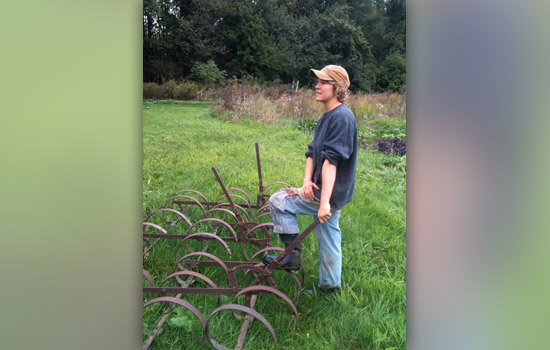RIT Students Learn the Homegrown Advantage at Mud Creek Farm
Community supported agriculture becomes a design-thinking project opportunity
Xanthe Matychak
Erin Bullock, owner of Mud Creek Farm
Rochester Institute of Technology students are learning to get their hands dirty—with the help of Erin Bullock, owner of Mud Creek Farm.
In the fall quarter, five students from Xanthe Matychak’s Design-thinking class at RIT’s E. Philip Saunders College of Business worked on a “Food Systems Innovation” project at Bullock’s 15-acre farming operation in Victor. While there, they also met with Luke Stodola, owner of Small World Bakery on South Plymouth Avenue. The bakery and the farm collaborate and operate primarily through a membership program similar to the Community Supported Agricultural model.
The Design-thinking class offers a process for helping designers collaborate with clients to find innovative products, services and systems. The classroom themes vary—last year students worked on urban innovation, while this year they concentrated their efforts on the farming trade, collaborating with small- to mid-size farmers, processors and distributors in the Rochester-metro area.
“While working with Erin and Luke of Mud Creek Farm and Small World Bakery, my group and I realized several things about mid-scale farming,” says Kimberly White, a fourth-year graphic design student and president of the Alpha Sigma Alpha Gamma Iota Chapter. “The mid-sized farms in the U.S. aren’t being paid enough attention. There is a lack in farming equipment for such-size farms, and they are using their creativity to makeshift a lot of their own tools.”
White and four other students—Kristen Duhaime, Jordan Pingitore, Donnie Maguire and Gerard LeClair—discovered a “Goldilocks problem.”
“The tools available to small farmers and processors are either too small, for serious home gardeners, or too big, for industrial farmers,” says Matychak, visiting lecturer in RIT’s Saunders College. “So the students worked with Erin and Luke to develop an appropriately scaled tomato trellis for the farm and an oat roller for the bakery because currently, Luke sends his oats out-of-state for processing.”
Bullock says she has “more than a 100 problems that need to be to solved at Mud Creek Farm, so that fact alone overwhelmed the students a little.”
“We have a ‘Pick-Your-Own’ garden for our members and we grow a lot of cherry tomatoes and one of the problems that we’ve seen is that the tomatoes outgrow the trellis,” Bullock explains. “We have close to 600 feet of tomatoes so what we needed had to be easy, quick and cheap.
“The students designed a prototype of an extension trellis for our regular trellising system that would allow vines to keep growing and theoretically yield more, but we’ll have to wait until next August to see if it works,” she says with a laugh.
The pesticide-free sustainable farm grows vegetables, herbs and flowers for 220 family members who belong to the farm for the whole season from June through October.
“I believe if we can find enough farmers who need tools at this scale, then we may be able to develop a suite of farm and processing tools with commercial potential,” Matychak says. “Every aspect of new product development is found in our food systems—where raw materials come from, how they are processed, marketed and distributed to the customers. It’s all there with opportunities for innovation and design-intervention every step of the way.”
White says the project opened her eyes to the difficulties of owning and tending a farm seven days a week. “Both Erin and Luke are very passionate about showing the Rochester community the benefits of being sustainable and using organic practices,” she says. “I give them a lot of credit and thanks for everything they do, and for teaching us about the importance of sustainable living.”













